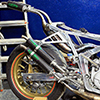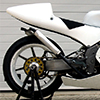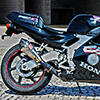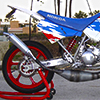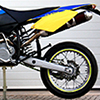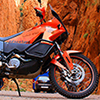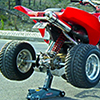Racing
SM
PORTUGUESE 2-STROKE SPIRIT !
STUDIES
Welcome to the RacingSM studies section.
A passionate subject and of great relevance in the performance and character of a 2-Stroke engine is without a doubt the ignition. In the analysis of the monocylindrical one, some decisions have to be taken, to know:
1. The ideal weight of the set crankshaft + flywheel, for a determined engine character/behaviour.
2. Distribution of that weight between crankshaft and the flywheel.
We know that an higher weight in the set favours the traction, a progressive engine, and mainly engines with bigger piston displacements that operate in low rotation regimes, independently of the linear speed of the piston; this is because it favors the decreases and averages rotations, not favoring the high rpms, conferring of this way, to a less explosive and more usable character to the engine. (Examples: Engines with high stroke, low engine rotations, much torque, round engine horspoewer curve, great accelerations and low-mid top speeds.)

On the other hand, peaky engines, with lower piston displacements and/or with high levels of crankshaft rotation, present greater speed and acceleration with a lesser weight in the set, mainly in high rotation (in this version they will be always with worse low and mid rpms, but with better high rpms - where if it finds the power peak in an peaky engine). In raised regimes of rotation, we can almost affirm that how much less weight, better (F1 case). This little weight brings as disadvantages the following phenomena:
Basically the principles for the monocylindrical one are these; for multi/pluri cilynder, these principles are remained, but new phenomena appear.
The configuration in Line - "Twin" or "V", normally is related in the first case to 180 in 180 degrees explosions to each crankshaft rotation and the "V" to a separation between explosions of 90º, followed of 270º without explosions. However the first version has potential to a more explosive and peaky character, and the second for a bigger control and traction/presentation of the torque and power.
For who intends maximum power, he will have to opt to the “Twin” configuration, being that for who it intends more torque, traction and control will have to opt to the "V". Another characteristic of the Twin, is that for to be to analyze the 2-Stroke engine, with explosion for cylinder to each rotation of the crankshaft, in necessary moment where a piston initiates the difficult ascent of the BDC for the TDC (mainly thus that the exhaust window for the effect is closed compression), it receives the support proceeding from the explosion in the other cylinder, being of this helped form: the two cylinders are helped mutually, for that it strengthens its TWIN character.
We have therefore a highest number of explosions, that associated to a 2-Stroke explosive character making rotation, will be able to confer a highest power in high regimes.
It makes possible the great magic, the great dream.....but..... what’s the great dream?
It is treated to change the position of the crankshafts in such form, that explosions of 90º in 90º are obtained (SCREAMER System), in contrast of the traditional explosion order in the 500 GP, with 2 simultaneous explosions followed of others 2 in simultaneous passed 180º of crankshaft rotation.
The 2nd version, standard, isn't more than a double Twin, with very identical sound.
The 1st version, for the fact to separate the explosions and to eliminate its concurrence, confers a F1 sound alike to the engine.
Let's see: if a 500 GP engine, with four 125 cylinders cm3 (54*54,5) reving till 13 500 RPM (values of the MotoGP 125/250), we will have 13 500 * 4 explosions when the engine goes in the maximum. This corresponds the 900 explosions for second! Or either, in the Screamer version, with the engine reving in max RPM, we will have inside 1 SECOND, 900 explosions separated ones between itself!
It's equivalent to fraction 1 second into 900 parcels and to know that in each one of them it's an 125 cm3 explosion - That is F1! It creates a supersonic effect!
And... for beyond the incredible sound, which impact it will have in the behavior of the engine? It's peaky, with worse low and mid power, but with incredible top power, in a cocktail of high explosions in regimes incomparable.
1. The ideal weight of the set crankshaft + flywheel, for a determined engine character/behaviour.
2. Distribution of that weight between crankshaft and the flywheel.
We know that an higher weight in the set favours the traction, a progressive engine, and mainly engines with bigger piston displacements that operate in low rotation regimes, independently of the linear speed of the piston; this is because it favors the decreases and averages rotations, not favoring the high rpms, conferring of this way, to a less explosive and more usable character to the engine. (Examples: Engines with high stroke, low engine rotations, much torque, round engine horspoewer curve, great accelerations and low-mid top speeds.)

On the other hand, peaky engines, with lower piston displacements and/or with high levels of crankshaft rotation, present greater speed and acceleration with a lesser weight in the set, mainly in high rotation (in this version they will be always with worse low and mid rpms, but with better high rpms - where if it finds the power peak in an peaky engine). In raised regimes of rotation, we can almost affirm that how much less weight, better (F1 case). This little weight brings as disadvantages the following phenomena:
- More vibrations from the engine.
- Faster accelerations in Neutral gear (due to the lower inertia of the light set) causing more instability to the engine.
- Bigger consume of the mobile parts.
- Examples: engines with low stroke, bigger rpms, high top speed, great engine horsepower and horsepower curve very radical and peaky.
Basically the principles for the monocylindrical one are these; for multi/pluri cilynder, these principles are remained, but new phenomena appear.
The configuration in Line - "Twin" or "V", normally is related in the first case to 180 in 180 degrees explosions to each crankshaft rotation and the "V" to a separation between explosions of 90º, followed of 270º without explosions. However the first version has potential to a more explosive and peaky character, and the second for a bigger control and traction/presentation of the torque and power.
For who intends maximum power, he will have to opt to the “Twin” configuration, being that for who it intends more torque, traction and control will have to opt to the "V". Another characteristic of the Twin, is that for to be to analyze the 2-Stroke engine, with explosion for cylinder to each rotation of the crankshaft, in necessary moment where a piston initiates the difficult ascent of the BDC for the TDC (mainly thus that the exhaust window for the effect is closed compression), it receives the support proceeding from the explosion in the other cylinder, being of this helped form: the two cylinders are helped mutually, for that it strengthens its TWIN character.
We have therefore a highest number of explosions, that associated to a 2-Stroke explosive character making rotation, will be able to confer a highest power in high regimes.
It makes possible the great magic, the great dream.....but..... what’s the great dream?
It is treated to change the position of the crankshafts in such form, that explosions of 90º in 90º are obtained (SCREAMER System), in contrast of the traditional explosion order in the 500 GP, with 2 simultaneous explosions followed of others 2 in simultaneous passed 180º of crankshaft rotation.
The 2nd version, standard, isn't more than a double Twin, with very identical sound.
The 1st version, for the fact to separate the explosions and to eliminate its concurrence, confers a F1 sound alike to the engine.
Let's see: if a 500 GP engine, with four 125 cylinders cm3 (54*54,5) reving till 13 500 RPM (values of the MotoGP 125/250), we will have 13 500 * 4 explosions when the engine goes in the maximum. This corresponds the 900 explosions for second! Or either, in the Screamer version, with the engine reving in max RPM, we will have inside 1 SECOND, 900 explosions separated ones between itself!
It's equivalent to fraction 1 second into 900 parcels and to know that in each one of them it's an 125 cm3 explosion - That is F1! It creates a supersonic effect!
And... for beyond the incredible sound, which impact it will have in the behavior of the engine? It's peaky, with worse low and mid power, but with incredible top power, in a cocktail of high explosions in regimes incomparable.
When it is pondered to create and to develop a prototype, there are several decisions that had to be taken, in conscience, after a long and recommendable reflection, based on the nature of the end item that if it intends and on the available ways to conceive it.
Everything this, having as deep cloth of the acquired and existing knowledge, to all the levels, that are the base of everything this. Of this mix/cocktail, it will start to appear the sketch of the specifications that the machine will possess.
Conception of the type of preparation that if it intends, in function of the following parameters:
Everything this, having as deep cloth of the acquired and existing knowledge, to all the levels, that are the base of everything this. Of this mix/cocktail, it will start to appear the sketch of the specifications that the machine will possess.
Conception of the type of preparation that if it intends, in function of the following parameters:
- Mechanical characteristics of the existing materials/Spare Parts in the Portuguese and International market, or either, special parts that do not equip any standard/stock model, but that they are conceived to improve these models. (WISECO forged pistons, Hot-Rods connecting-rods, new head domes with different combustion volumes, etc)
- Knowledge of the specific characteristics of the materials that equip the available motorcycles in the market, given that these motorcycles exist in the market, and the respective components are sold in the market of spare parts.
- Levels of Resistance of these same materials; we can have information if we know the characteristics of these materials and motorcycles where they apply, to be able to survey with some reliable level its resistance to the loads we intend them to be subject.
- Global available budget.
- Character of the end item.
- Persistence.
- Work.
- Organization of the tasks to play, to maximize the efficiency of the same and the project management to avoid the project to become a nightmare.
- Varied Contacts.
- Good relations.
In this mater, we have to distinguish clearly the 2-Stroke engine from the 4-Stroke engine: while in the 2-Stroke the ports are in the sleeve, in the 4-Stroke they are in the head:
For this reason, the 2-Stroke engine can never be hipersquare like the 4-Stroke, for reasons of dimensions, timings and areas of gases passages and mixture, and also for the compression effect.... that is to say, that in a 4-Stroke, we will be able to reduce the stroke until very low values, with great piston diameter, while in the 2-Stroke this unbalance already becomes the performance of the engine (torque and power) more difficult to obtain....
2-STROKE
Actually, 2-Stroke engine continues to be the best specific power engine.
4-STROKE
Road Racing: In the standard automobiles, the engines possess not rare times bigger stroke that the piston displacement, for the fact they twirl in low rotations and because it’s necessary high doses of torque pushing the high weights and masses of the automobile.
But in the competition engines, that impulse light chassis, and that for this reason they do not need so many torque in such a way, being able to possess greater power, the constructors opt to reduce greatly the crankshaft stroke, to take off great regimes of rotation (F1 type, with great linear movement speed of the pistons), that great piston diameter do not penalize very in consuming terms, for the fact of terms only one explosion in each 2 turns of the crankshaft (one of rest, that gives rest to the piston.
On the other hand, we can ourselves be given to the luxury to benefit with these engine quotes, the power, for the fact that the 4-Stroke engine is, by nature, an engine with torque.
Therefore, for Speed Circuits, 4-Stroke use great piston diameter, short crankshaft stroke, many valves on the head with reinforced springs, the best materials, long lenght connecting-rods relatively to the crankshaft stroke (to allow that the piston has little attritions in the cylinder and facilitates the high rotations, face to the great diameter of the piston), and high compression ratio; we have also high volumes of gases, admission, exhaust, to allow the engine to breath correctly in high rotations and to allow the obtaining of power.
One another aspect, is the valve timings functioning: the distribution is conceived to open the exhaust valves more early, and to allow more time of opening and exit of gases, it makes possible greater regimes of rotation and breath for high power.
If we intend to obtain the maximum theoretical power, we must also appeal to an ignition with an order of possible explosion the most alternated possible, of form to harness high regimes, this way the engine shows it’s power and torque in a more brusque and aggressive form (in the competition this situation does not happen many times, for the fact that in circuits with many curves, where power, acceleration control and binary are fundamental factors to win).
In these cases, the manufactors create big-bang firing engine, in order to obtain a better tractability and control of the bike itself, maintaing the radical engine quotes with high piston diameter and very reduced crankshaft stroke to allow high rotation regimes with aceptable piston linear movement speed.
Or in the other hand, an engine more conventional with bigger crankshaft stroke, lower piston diameter, using radical camshaft timings and a Screamer firing order, with the most alternated explosions possible.....
The tests and know-how of each manufacturer enter there in game, but in the essential, the competition is very difficult to gain themselves with a radical machine/engine, being necessary to get a commitment between the two worlds...
Motocross/Enduro: Bigger crankshaft stroke, but also very inferior relatively to piston diameter, to harness a bigger leverage, and more conservative timings of the valves benefiting the torque with fast and controlable delivery power. Linear piston movement speed is also lower.
For this reason, the 2-Stroke engine can never be hipersquare like the 4-Stroke, for reasons of dimensions, timings and areas of gases passages and mixture, and also for the compression effect.... that is to say, that in a 4-Stroke, we will be able to reduce the stroke until very low values, with great piston diameter, while in the 2-Stroke this unbalance already becomes the performance of the engine (torque and power) more difficult to obtain....
2-STROKE
- Road Racing: Piston Diameter = or a little higher than Crankshaft Stroke
- Motocross/Enduro: Piston Diameter = or a little lower than Crankshaft Stroke
- Necessity of Compression (the effective compression only occurs from the moment where the piston closes the exhaust port in its ascending course), for a bigger generation of energy;
- Better dynamic of the gases, and linearity of its passage in the engine;
- Necessity of leverage – not very reduced stroke and not very raised Connecting-Rod Attack Angle of the crankshaft.
- Possibility to take off advantage of relatively lightweight pistons, ideal for high rotations with an explosion for each crankshaft turn, two power factors.
- Remember that power is not more than torque x rotation, being its exponent maximum the 2-Stroke engine, with its explosion for each crankshaft turn, very rotating, with a high level of tuning in terms of power attainment, or either, very peaky, with areas and timings raised and close-ratio gearboxes.
Actually, 2-Stroke engine continues to be the best specific power engine.
4-STROKE
Road Racing: In the standard automobiles, the engines possess not rare times bigger stroke that the piston displacement, for the fact they twirl in low rotations and because it’s necessary high doses of torque pushing the high weights and masses of the automobile.
But in the competition engines, that impulse light chassis, and that for this reason they do not need so many torque in such a way, being able to possess greater power, the constructors opt to reduce greatly the crankshaft stroke, to take off great regimes of rotation (F1 type, with great linear movement speed of the pistons), that great piston diameter do not penalize very in consuming terms, for the fact of terms only one explosion in each 2 turns of the crankshaft (one of rest, that gives rest to the piston.
On the other hand, we can ourselves be given to the luxury to benefit with these engine quotes, the power, for the fact that the 4-Stroke engine is, by nature, an engine with torque.
Therefore, for Speed Circuits, 4-Stroke use great piston diameter, short crankshaft stroke, many valves on the head with reinforced springs, the best materials, long lenght connecting-rods relatively to the crankshaft stroke (to allow that the piston has little attritions in the cylinder and facilitates the high rotations, face to the great diameter of the piston), and high compression ratio; we have also high volumes of gases, admission, exhaust, to allow the engine to breath correctly in high rotations and to allow the obtaining of power.
One another aspect, is the valve timings functioning: the distribution is conceived to open the exhaust valves more early, and to allow more time of opening and exit of gases, it makes possible greater regimes of rotation and breath for high power.
If we intend to obtain the maximum theoretical power, we must also appeal to an ignition with an order of possible explosion the most alternated possible, of form to harness high regimes, this way the engine shows it’s power and torque in a more brusque and aggressive form (in the competition this situation does not happen many times, for the fact that in circuits with many curves, where power, acceleration control and binary are fundamental factors to win).
In these cases, the manufactors create big-bang firing engine, in order to obtain a better tractability and control of the bike itself, maintaing the radical engine quotes with high piston diameter and very reduced crankshaft stroke to allow high rotation regimes with aceptable piston linear movement speed.
Or in the other hand, an engine more conventional with bigger crankshaft stroke, lower piston diameter, using radical camshaft timings and a Screamer firing order, with the most alternated explosions possible.....
The tests and know-how of each manufacturer enter there in game, but in the essential, the competition is very difficult to gain themselves with a radical machine/engine, being necessary to get a commitment between the two worlds...
Motocross/Enduro: Bigger crankshaft stroke, but also very inferior relatively to piston diameter, to harness a bigger leverage, and more conservative timings of the valves benefiting the torque with fast and controlable delivery power. Linear piston movement speed is also lower.
The 2-Stroke engine possesses magic... this we all know, any person who has engine knowledge knows it... But WHY?
The answer is in the nature of the engine itself.... An explosion for each crankshaft rotation, lightweight materials, few components, dynamics of the gases and sound....
The 2-Stroke exhaust plays a fundamental role, in the attainment of performance values, for the fact that it receives the burnt mixture and accumulates it, later to return to the entrance of the cylinder... this phenomena is given to the fact of at the moment of each explosion, the gases arrive at the end of the exhaust to the speed of the sound (supersonic), for initiating its jib wave there and still pushing the cool mixture inside the cylinder again and there being burned in the following explosion.
All this dynamics, allows that a direct relation exists between the cylinder and the exhaust, in terms of flows, areas, gas passage speed and PRESSURE of the same ones; for this reason, to get a high power of a 2-Stroke engine, these cool and burnt gases will be had to obtain one high pressure of all, in a game of tasks to a highly speed.... Only this will be able to create power and to take off left of from this wonderful engine.
But... the magic of the 2-Stroke... what it is? In the reality it’s the exponential character that this engine can have, as a 4-Stroke does not obtain - from there the 2-Stroke engine is excellent for power creation, ideal for light machines, and the 4-Stroke more vocationed for torque, the ideal one for heavy machines. However if we add to these characteristics of 2-Stroke engines, a plurality of cylinders to blow up more alternatingly possible, will have a creation of an exceptional power, with a behavior 100% radical and racing in open road..... (ignoring values of consumption and longevity of the materials).
The answer is in the nature of the engine itself.... An explosion for each crankshaft rotation, lightweight materials, few components, dynamics of the gases and sound....
The 2-Stroke exhaust plays a fundamental role, in the attainment of performance values, for the fact that it receives the burnt mixture and accumulates it, later to return to the entrance of the cylinder... this phenomena is given to the fact of at the moment of each explosion, the gases arrive at the end of the exhaust to the speed of the sound (supersonic), for initiating its jib wave there and still pushing the cool mixture inside the cylinder again and there being burned in the following explosion.
All this dynamics, allows that a direct relation exists between the cylinder and the exhaust, in terms of flows, areas, gas passage speed and PRESSURE of the same ones; for this reason, to get a high power of a 2-Stroke engine, these cool and burnt gases will be had to obtain one high pressure of all, in a game of tasks to a highly speed.... Only this will be able to create power and to take off left of from this wonderful engine.
But... the magic of the 2-Stroke... what it is? In the reality it’s the exponential character that this engine can have, as a 4-Stroke does not obtain - from there the 2-Stroke engine is excellent for power creation, ideal for light machines, and the 4-Stroke more vocationed for torque, the ideal one for heavy machines. However if we add to these characteristics of 2-Stroke engines, a plurality of cylinders to blow up more alternatingly possible, will have a creation of an exceptional power, with a behavior 100% radical and racing in open road..... (ignoring values of consumption and longevity of the materials).


